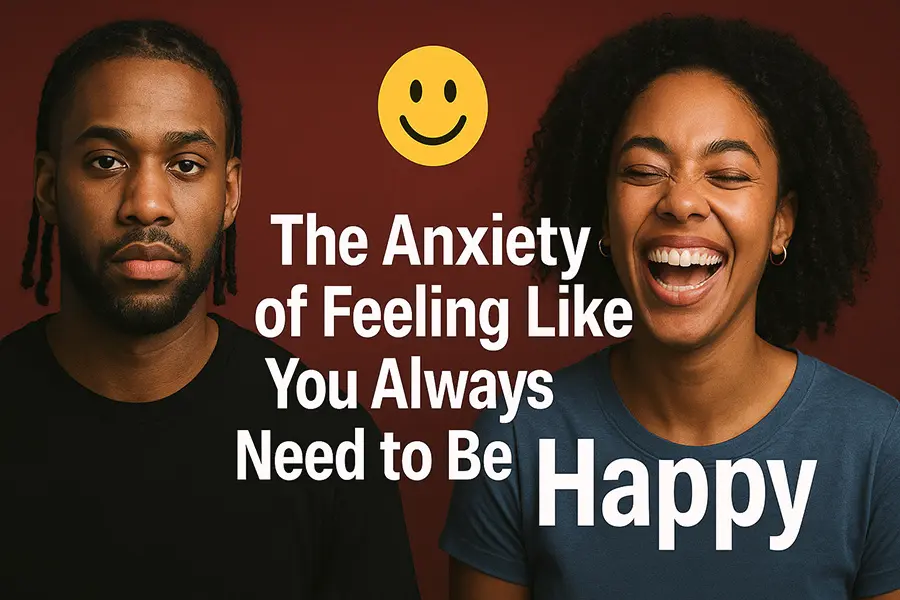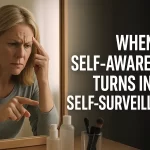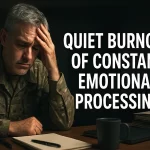“Be grateful.” “Stay positive.” “Good vibes only.” It sounded helpful until it wasnt. I found myself panicking anytime sadness, frustration, or numbness arose. I feared I was failing at happiness. Thats the quiet anxietty of feeling like you always need to be happy
Table of Contents
- Introduction
- Why We Feel Pressured to Be Happy All the Time
- The Hidden Costs of Chasing Constant Happiness
- How Your Brain Handles Emotions
- Practical Ways to Let Go of Happiness Pressure
- Happiness Pressure and the LGBTQ+ Experience
- Q&A: Your Questions Answered
- Conclusion: Embrace Your Full Emotional Range
Introduction
Ever feel like youre supposed to be happy 24/7, like it’s some kind of job requirement for life? I totally get it 😅 a while back I was going through a rough patch nothing major, just one of those weeks where everything felt heavy. Friends kept saying “Just stay positive” or “You’ve got so much to be grateful for!” It was like my sadness wasnt allowed, and I started panicking, thinking I was failing at being happy. That’s the sneaky anxiety of feeling like you always need to be happy
This pressure can hit hard, especially if you’re part of the LGBTQ+ community, where societal expectations might make you feel like you have to put on a brave face to prove you’re “okay.” In this guide, we’ll dig into why this pressure exists, how it messes with your head, and practical ways to let it go. Whether you’re stressed about work, relationships, or just life, you’re not alone, and you can find peace by embracing all your emotions. Ready to ditch the “good vibes only” trap?

Why We Feel Pressured to Be Happy All the Time
So, why does it feel like we’re supposed to be smiling all the time? Let’s break it down.
Society’s Happiness Obsession
From self-help books to Instagram influencers, we’re bombarded with messages that happiness is the ultimate goal. Phrases like “choose joy” or “good vibes only” are everywhere, making it seem like sadness or anger are failures. Social media doesn’t help those curated posts of perfect vacations and smiling faces can make you feel like you’re the only one who’s ever down.

Research backs this up. A study in Scientific Reports found that the pressure to be happy can actually make you feel worse, especially in societies that rank high on happiness indexes. It’s like the more we’re told to be happy, the harder it is to actually feel it.
Personal Roots of the Pressure
On a personal level, things like perfectionism or childhood experiences can crank up this pressure. If you grew up hearing “don’t cry” or “be strong,” you might’ve learned that negative emotions are bad. Perfectionists, especially, might see anything less than happiness as a sign they’re not doing life right. I used to think if I wasn’t happy, I was letting everyone down until I realized that was just my brain playing tricks on me.

- Self-help culture glorifies constant positivity
- Social media highlights perfect joy snapshots
- Childhood messages may discourage “negative” emotions
- Perfectionism frames happiness as moral success
The Hidden Costs of Chasing Constant Happiness
Trying to stay happy all the time isn’t just tough it can really mess with your mental health. Here’s how:
Suppressing Your True Feelings
When you’re told to “stay positive,” you might start pushing down sadness, anger, or anxiety. But bottling up emotions doesn’t make them go away it makes them louder. Over time, this can lead to emotional exhaustion or even physical symptoms like headaches or fatigue. I once tried to “smile through” a tough week, and by Friday, I was so drained I could barely get out of bed.
Ramping Up Anxiety
The pressure to be happy can make you anxious about not being happy. You might worry, “Why am I sad? What’s wrong with me?” This creates a vicious cycle where the more you chase happiness, the more stressed you get. According to Psychology Today, this pressure can make it harder to actually feel good.

Losing Touch with Yourself
Constantly faking happiness can disconnect you from your authentic self. You might stop noticing what you really feel or need, focusing instead on looking “okay” to others. This can make it tough to figure out what truly matters to you. For more on staying connected to your emotions, check out our Emotional Self-Care Guide.
- Suppresses natural emotional range
- Triggers shame for experiencing normal lows
- Disconnects from authentic self-awareness
- Increases anxiety about mood dips
How Your Brain Handles Emotions
Feeling a range of emotions isn’t just okay it’s essential. Your brain is wired to process all kinds of feelings, and here’s why that’s a good thing.
Emotions as Signals
Think of emotions like messages from your brain:
- Sadness might mean you need comfort or a change in your life.
- Anger can signal a crossed boundary, pushing you to protect yourself.
- Anxiety alerts you to potential challenges, helping you prepare.

Suppressing these emotions is like ignoring a warning light on your car it doesn’t fix the problem, it just makes it worse.
The Science of Feeling (mental wellness strategies)
Your brain’s amygdala handles emotional responses, while the prefrontal cortex helps you regulate them. When you try to force happiness, these parts can clash, causing stress. Harvard Health says embracing all emotions builds resilience and better mental health. As Dr. Susan David, author of Emotional Agility, puts it, “Discomfort is the price of admission to a meaningful life.” Learn more at susandavid.com.
- Survival brain equates negative emotions with danger
- Perfectionist wiring demands flawless mood control
- Shame loops punish emotional dips harshly
- Lack of emotional modeling leaves discomfort unprocessed
Practical Ways to Let Go of Happiness Pressure
Ready to ditch the pressure and embrace all your emotions? Here are some practical strategies to get you started:
Accept Your Emotional Range
Give yourself permission to feel everything joy, sadness, anger, all of it. Try the 5-4-3-2-1 mindfulness technique: notice 5 things you see, 4 you can touch, 3 you hear, 2 you smell, and 1 you taste. It grounds you in the moment and helps you accept your feelings without judgment. Our Mindfulness for Beginners guide has more tips.

Practice Self-Compassion
When you’re feeling down, talk to yourself like a friend. Instead of “I shouldn’t be sad,” try, “It’s okay to feel this way everyone does sometimes.” A self-compassion break placing a hand on your heart and saying, “I’m here for myself” can work wonders. I started doing this after a tough day, and it felt like a warm hug. Check out Building Self-Compassion for more.
Say No to Toxic Positivity
If someone’s pushing “just be happy” vibes, set a boundary. You might say, “I appreciate the support, but I need to feel this right now.” Also, curate your social media to follow accounts that embrace real emotions, not just fake smiles. Our Self-Care and Digital Minimalism article can help you navigate this.
Express Your Emotions
Let your feelings out through journaling, talking to a trusted friend, or creative outlets like drawing or music. Write down what you’re feeling without editing it’s like letting your emotions breathe. I started journaling after a breakup, and it helped me process without judgment. See Journaling for Mental Health for prompts.
Ground Your Nervous System
When anxiety spikes, try deep breathing: inhale for 4, hold for 4, exhale for 4. Or do a body scan to release tension. Say to yourself, “I’m safe, even when I’m not happy.” This helped me calm down when I was stressing about not being “positive enough.”

How to Gently Release Happiness Pressure
1️⃣ Normalize Emotional Fluctuation
“I’m allowed to feel both joy and pain. All emotions are temporary visitors.”
2️⃣ Reframe Negative Feelings as Signals, Not Failures
- Sadness = unmet needs
- Frustration = boundaries or values activated
- Anxiety = nervous system alert needing safety, not shame
3️⃣ Practice Emotional Allowance Routines
- Daily mood check-ins without judgment
- Label emotions neutrally
- Breathwork to stay present with discomfort
4️⃣ Unfollow Toxic Positivity Influences
- Curate social media toward emotional honesty
- Seek models of full emotional range expression

5️⃣ Build Nervous System Flexibility for Emotional Waves
- Remind: “Feeling low isn’t permanent or dangerous.”
- Self-soothe without rushing relief
- Notice the body’s rising and settling naturally
Happiness Pressure and the LGBTQ+ Experience
For LGBTQ+ folks, the pressure to always be happy can feel like an extra weight. Society often expects you to “prove” you’re thriving despite discrimination or stereotypes, which can make it harder to admit when you’re struggling. Maybe you feel like you have to smile through microaggressions or hide your true feelings to fit in. But your emotions happy or not are valid, and you don’t have to perform happiness to be worthy.
Try connecting with supportive communities or therapists who understand these unique pressures. The Trevor Project offers amazing resources for LGBTQ+ mental health. I know someone who found relief by joining an LGBTQ+ support group it was like finding a safe space to just be.

Q&A: Your Questions Answered
Got questions about this happiness pressure? Let’s tackle some common ones:
Q: Isn’t positivity a good thing?
A: Sure, when it’s genuine! But forcing positivity can make you ignore real feelings, which leads to stress. Balanced positivity where you honor all emotions is the way to go. Psychology Today explains this well.
Q: Won’t focusing on negative emotions make me feel worse?
A: Not if you process them healthily. Acknowledging emotions helps you move through them, not get stuck. Suppressing them is what makes them linger. Try journaling or talking it out to see the difference.
Q: How do I stop feeling guilty for not being happy?
A: Remind yourself that all emotions are part of being human. Try a self-compassion mantra like, “I’m allowed to feel this.” It helped me stop beating myself up for having off days.

Q: What if social media makes me feel like I’m failing at happiness?
A: Curate your feed to include authentic voices, and take breaks when needed. Our Self-Care and Digital Minimalism guide has practical tips.
Q: Can therapy help with this?
A: Absolutely. A therapist can help you navigate these pressures and build emotional resilience. BetterHelp is a great place to start.
Conclusion: Embrace Your Full Emotional Range
You don’t have to be happy all the time to live a meaningful life. True wellness comes from embracing your full emotional range joy, sadness, anger, and everything in between. By letting go of the pressure to always be happy, you can connect with your authentic self and find peace in the moment. As Dr. Susan David says, “Discomfort is the price of admission to a meaningful life.”
So, give yourself permission to feel it all. Try one of these strategies today maybe a quick mindfulness exercise or a kind word to yourself and see how it feels to just be. What’s one way you’re gonna let yourself feel today? Drop it in the comments we’re cheering you on! 😊 For more mental wellness tips, explore our Self-Care Hub.

You’re Not Failing By Feeling
Happiness isn’t a full-time job. True well-being honors every emotional shade, not just the bright ones. You’re allowed to feel fully, adapt gently,, and thrive beyond perfectionist joy expectations. Emotional range is not weakness it’s wholeness..
Internal Links:
- Self-Care Hub
- Emotional Self-Care Guide
- Mindfulness for Beginners
- Building Self-Compassion
- Self-Care and Digital Minimalism
External Links:
- Scientific Reports: Perceiving societal pressure to be happy
- Psychology Today: The Pressure to Be Happy
- Harvard Health: Why it’s healthy to feel a range of emotions
- The Trevor Project: LGBTQ+ Mental Health Support
✨ Last updated on 11.08.2025











Leave a Reply